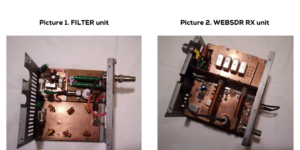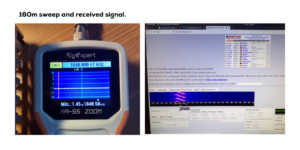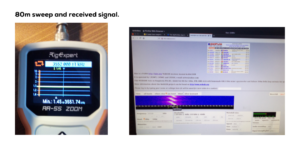Evaluation of the two-band WEBSDR using the RigExpert AA-55 ZOOM antenna analyzer. Part 1
Those interested in low-band Dxing know the importance of the ability to copy weak DX signals, especially on 160 meters. Unfortunately, the white noise situation in urban areas is worsening daily. So, the obvious solution is to install the WEB receiver in some quiet rural place away from the noise sources.
We decided to install the public WEBSDR at the country site 30 km from Lviv in KN19XM for easy maintenance access and the possibility for local club members to use it.
WEBSDR software http://websdr.ewi.utwente.nl:8901/ which has the shortest signal processing delay time (perfect for the contest use) has been chosen for this project.
Hardware
The 160m receiver is Afedri-Net SDR https://www.afedri-sdr.com/, 80m receiver is RTL-SDR https://www.rtl-sdr.com/about-rtl-sdr/ stick with the homemade ON1BES SBL1 upconverter https://www.on1bes.be/sdr_up_conv_v3.0_ade1_125_en.html and corresponding two band splitter, highpass and bandpass filters. W7IUV 2N5109 preamplifier http://www.hamlan.org/tech/w7iuvpreamp/
.
Firstly, RigExpert AA-55 ZOOM antenna analyzer was used to check the input characteristics of the input broadcast highpass filter and 160 and 80m input receiver bandpass filters that were tuned using the RIGOL DSA 815 spectrum/tracking analyzer.

AA-55 ZOOM was connected to the input of the broadcast band (BC) highpass filter with both output splitter ports loaded by 50 Ohm dummy loads. AA-55 ZOOM display shows that broadcast band signals below 1.8 MHz are effectively blocked.
The next step was to check the input impedance of the bandpass filters in series with the input broadcast band highpass filter.
The final evaluation procedure was to use the RigExpert AA-55 ZOOM analyzer as a stable signal source.

The sweep frequency range was set to a minimum of 1 kHz on the central frequencies of 1840 kHz and 3551 kHz and the signal was “delivered” to the WEBSDR input through 50dB step attenuator in the “Repeat” mode.
A local connection to the WEBSDR site using Mozilla Firefox was made, and the stable sweeping signal was immediately shown on the screen. The major advantage of using the RigExpert AA-55 ZOOM is the solid rock signal stability. Other analyzers require a long time to warm up but the frequency was still drifting.


RigExpert AA-55 ZOOM antenna analyzer was a useful and reliable tool to evaluate the receiving hardware for WEBSDR project.
Part 2 of this article will tell how RigExpert AA-55 ZOOM antenna analyzer was used to evaluate the two-band antenna for this WEBSDR.

